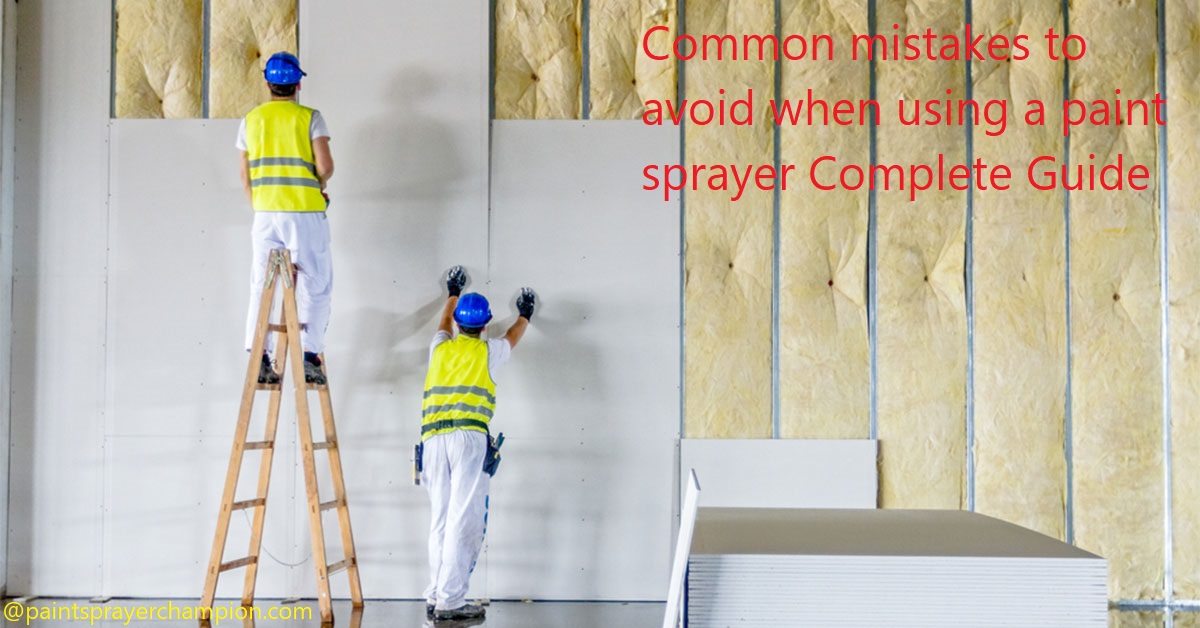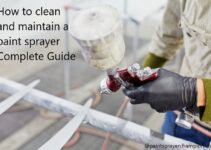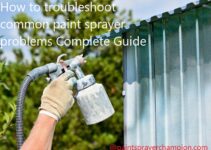Struggling with a paint sprayer? Want to make sure you don’t make any mistakes? In this article, you’ll learn the common mistakes to avoid when using a paint sprayer. Get the insight you need and ensure your project comes out looking great!
If you’re planning to paint a large space with a paint sprayer, there are several common mistakes that can be avoided. A paint sprayer can be a great tool for quickly and evenly covering walls and other surfaces with paint. However, if mistakes are made during the spraying process, it can lead to an uneven finish and subpar results.
In this guide, we’ll explain the most common mistakes that people make when using a paint sprayer and how to avoid them. By following these tips, you’ll be able to use your paint sprayer effectively in order to achieve the kind of professional-looking results that you desire.
Explanation of the importance of paint sprayers
Paint sprayers are an essential part of any painting job, and they’re an invaluable tool for both contractors and DIYers. Whether you’re working on a small project or a large one, paint sprayers save time and energy by allowing you to cover surfaces quickly and evenly with a fine mist or stream of paint or stain. They also provide greater control over application, so results are more consistent than when using regular brushes or rollers.
But paint sprayers can be tricky to use if you don’t understand all the factors that go into using them correctly. They require some basic knowledge about the type of materials being sprayed, how to set up the equipment and techniques for proper application. To avoid costly mistakes and wasted time, it pays to review some key tips that help ensure successful results.

Brief overview of common mistakes that people make when using a paint sprayer
Using a paint sprayer can be a great way to save time and money when you have to paint large surfaces. However, inexperienced users may find themselves making common mistakes that can easily be avoided. Here is an overview of some of the most frequent issues that arise when using a paint sprayer, as well as tips on how to avoid them:
1) Not cleaning the sprayer properly – A paint sprayer should always be cleaned after each use in order to prevent clogging and ensure optimal performance. Clean the nozzle thoroughly with mineral spirits or other suitable solvents before storing the equipment, and change the filters if necessary.
2) Not thinning the paint correctly – Many types of paints will require thinning before they can be sprayed through a sprayer, as too thick an application may cause blockages or poor results. Make sure to follow manufacturers’ instructions for thinning correctly, as this will ensure a smooth flow of material through the nozzle and even coverage on the surface being painted.
3)Overloading the gun – Overloading your gun with too much paint at once can lead to uneven spraying patterns, drips on surfaces and poor coverage overall. It is important to give yourself enough time between refills so that you don’t overload your machine and achieve better results with each pass over the surface you’re painting.
4) Not wearing protective gear – Paint fumes from some materials are harmful when inhaled directly over long periods so it is important to wear safety equipment such as goggles, face masks and gloves when using a spray gun for painting projects. Safety glasses that provide protection against reflective light should also be worn during operation due to their potential for eye injury caused by splashes or droplets of airborne material reaching your eyes while spraying.
Purpose of the guide
This guide aims to ensure that you are familiar with all key aspects of using a paint sprayer correctly and understand the potential mistakes you might be prone to make. It covers the following topics:
-Safety precautions to keep in mind when handling a paint sprayer
-The different painting projects best suited for a paint sprayer
-Tips on how to properly set up your equipment, such as understanding its controls and proper maintenance
-Various techniques you can employ with a paint sprayer to achieve satisfactory results
-Common mistakes experienced by DIY painters and advice on how to avoid them
Choosing the Right Sprayer
It is important to ensure that you are choosing the right paint sprayer for the job. Paint sprayers come in a variety of shapes and sizes, from small, handheld paint sprayers for detailed work to larger models for large-scale projects. When selecting a paint sprayer, consider your project size and the type of surfaces you are painting. You should also check what types of paint the device is compatible with – some devices can only work with certain types of materials.
It is highly recommended to buy a high-quality model which has adjustable features so that it can cater to various projects and surfaces. Additionally, use one that has multiple settings so that you can adjust it to achieve different effects such as smooth or textured finishes.
Ultimately, choose a model which matches your budget while providing sufficient power and features for successful results.
Types of paint sprayers and their differences
Before you begin your project, you need to understand the types of paint sprayers available and select the one that best fits your needs. Generally, these are categorized into HVLP (High Volume Low Pressure) or LVLP (Low Volume Low Pressure) sprayers. Both types use a hand-held gun to dispense a mist of paint onto the surface below.
HVLP sprayers are typically used for large projects and have the capability to handle thicker paints and lacquers than LVLP sprayers. The tradeoff is that HVLP sprayers require more time for setup and cleanup due to the higher flow rate at which they operate, making them better suited for professional use.
Conversely, LVLP sprayers are ideal for more precise projects such as intricate trim work where accuracy is key instead of speed. These machines operate at lower pressure levels resulting in reduced overspray and therefore require less time investment during preparation and clean up between applications of different colors or finishes. They can also be used with a wide range of paint viscosities including water-based paints, stains, primers and other finishes without requiring skilled operators capable of setting up air compressors or regulators needed by HVLP models.
Factors to consider when choosing a paint sprayer
The type of paint sprayer you choose is also important. There are two main types — airless and compressed air sprayers. Airless sprayers are generally considered the best choice for large projects, while compressed air sprayers are better for smaller or intricate applications. It’s important to consider your budget and the size of your project when selecting a type of paint sprayer.
Another factor to consider is the brand and model of paint sprayer you select. Many have different features such as adjustable nozzle sizes, variable pressure settings, and pattern shape control. It’s also important to research reviews before making a purchase. The performance features, especially for airless models, might vary greatly between brands, so it pays to compare them carefully before making a decision. In addition, there may be some servicing involved in order to ensure that the user gets the most out of their equipment over time.

Preparing for Painting
Before getting started, it is important to ensure that your surface preparation is up to par. The room should be adequately ventilated with either an exhaust fan or open doors and windows. Any furniture should be removed or covered with plastic sheeting, and carpets should be vacuumed before you begin painting. You may also need to make repairs on any scratches, chips, or dents in the background surfaces you are spraying.
Once this preparation is complete, be sure to clean the area thoroughly so that no dust interferes with the paint product when using a paint sprayer. A clean cloth used dampened with either mineral spirits or water will help remove any debris particles that may settle onto the surface and create uneven textures in your finish. This can also provide a smoother finish with fewer streaks when applying multiple coats of paint product.
Safety measures
The use of a paint sprayer requires vigilance at every step, as it is classified as a dangerous tool if used in the wrong way. It is important to remember that you should always wear safety equipment such as safety goggles and any other breathing protective equipment or clothing that covers your skin and hair when using a paint sprayer. The primary safety measure when using any power-actuated tool is to ensure that you disconnect the power supply from the front and back of the device whenever you are working on it.
Other tips for ensuring your safety include:
- Make sure the area where you plan to use your paint sprayer is well-ventilated, otherwise opt for using masks for better protection.
- Be aware of fumes that may be present when using the paint sprayer and ensure to wear an appropriate mask so you don’t inhale them.
- Always wear protective clothing as droplets of oil or paint can cause skin irritation or burns.
- Read through your owner’s manual carefully before beginning to use your paint sprayer, being sure to review all parts diagrams, operating instructions and maintenance instructions.
- It’s also important to take breaks from painting with a paint sprayer as extended use can cause tiredness, headaches, drowsiness, dizziness and other symptoms of overexposure.
Surface preparation
Proper preparation of the surface is critical to getting a good outcome with any painting project. The results will depend on the materials that are needed and likewise the techniques you need to prepare the surface. When using a paint sprayer, it is important to also consider factors like humidity, airflow, temperature and so on.
Here are some of the common mistakes people make when preparing surfaces for painting with a paint sprayer:
- Not pre-cleaning surfaces: Lead to poor adhesion of primer, saturation of substrates where more primer may be required, poorer outcome in decorative finish quality, affecting final results and longevity of the job.
- Not adequately masking edges: Poor masking of edges can lead to accidental overspraying.
- Not smoothing surfaces prior to paint application: Surfaces should be smoothed first prior to applying primer or topcoat; this will help prevent unsightly brush marks or drips appearing on finished article.
- Overuse/not enough use of tack cloths/coating removers when cleaning surfaces: Too much tack cloth or coating remover removes all oils from substrate making it difficult for paints/primers/topcoats adhere correctly; not enough powder residue may result in poor adhesion or unevenness in coatings applied onto substrate due to foreign particles attaching themselves onto it and trapping air during curing process.
Material preparation
Material preparation is a crucial step in any painting job as it will have great effects on the finished result. To ensure acceptable quality results with a paint sprayer, the following guidelines should be followed:
- Thoroughly stir the paint and make sure it does not contain lumps, otherwise lumps can be sprayed out causing a texture to appear on the surface.
- Shake (or re-stir) the can regularly to make sure there are no settling solids that could cause an uneven color or clog in the nozzle.
- Dilute paints if necessary – always refer to a particular paint brand’s instructions for material preparation.
- If you are using a pre-mixed paint, this should already be diluted appropriately.
- Make sure to strain material through a cotton mesh or nylon net prior to applying (this helps ensure only particles of appropriate size make it into your spray gun).
- Be aware of flash rust; areas likely to become rusty may require special treatment before painting.

Conclusion
Paint spraying can be a great way to get a professional-looking finish for your project, but there are several common mistakes that should be avoided. Taking the time to do the proper preparation before you start will ensure that your project looks even better when you’re done. Proper cleaning and maintenance of your sprayer and using the correct technique will also help to get the desired results and longer paint life.
Starting with smaller projects is a great way to practice and build confidence in your spray painting skills. Following these tips will help you create that perfect finish every time.
FAQ’S
What can go wrong with a paint sprayer?
The paint sprayer can clog, drip, or produce an uneven coat of paint.
What precautions should be taken during spray painting?
Precautions include wearing protective gear, working in a well-ventilated area, and following safety guidelines for the specific paint and equipment.
What are the common problems during paint gun operations?
Common problems include over-spraying, under-spraying, and inconsistent spray patterns.
What do I need to know before using a paint sprayer?
You should know how to properly use and maintain the specific paint sprayer, including how to clean it and troubleshoot any potential issues.
How long can paint stay in sprayer?
Paint can stay in a sprayer for several hours to a few days, depending on the type of paint and the storage conditions.
What is the common defects of a paints?
Common defects include cracking, peeling, blistering, fading, and chalking.
When should you not spray paint?
Spray painting should not be done in windy or rainy conditions, or when the temperature and humidity levels are outside the recommended range.
What is the most common cause of paint defects?
The most common cause of paint defects is improper surface preparation before painting.
How can paint defects be prevented?
Paint defects can be prevented by properly cleaning and preparing the surface, using the correct type of paint for the surface, and following proper application techniques.
How do you prevent lines when spraying paint?
To prevent lines, use a consistent speed and distance when spraying, overlap each pass slightly, and use a high-quality paint sprayer with a properly adjusted spray pattern.
See Also:
- Best paint sprayer for exterior house
- Best paint sprayer for ceiling
- Best paint sprayer for cars
- Best handheld paint sprayer
- Best hvlp paint sprayer


